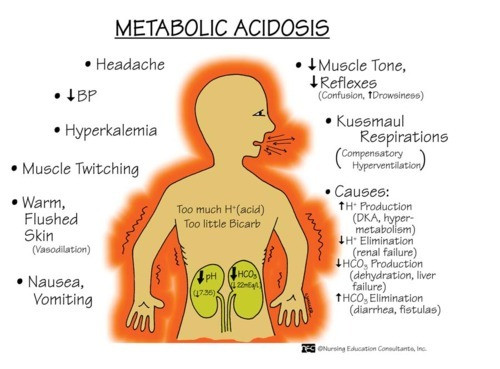Definisi
Gangguan keseimbangan asam basa adalah suatu kondisi ketika kadar asam dan basa dalam darah tidak seimbang. Keseimbangan asam basa diperlukan tubuh untuk menjalankan berbagai fungsinya dengan baik, seperti sistem pencernaan, metabolisme, dan produksi hormon.
Kadar asam basa dalam darah diukur melalui pemeriksaan darah menggunakan skala pH. Skala pH berada diantara 0 (sangat asam) hingga 14 (sangat basa) dengan nilai normal berkisar antara 7,35 - 7,45.
Peningkatan kadar asam dalam darah dapat menyebabkan pH menurun (< 7.35) sedangkan peningkatan kadar basa dapat menyebabkan pH meningkat (> 7.45). Ketika kadar asam dalam darah terlalu tinggi, hal ini disebut asidosis, sedangkan kondisi dimana kadar basa terlalu tinggi disebut alkalosis.
Organ ginjal dan paru-paru berperan untuk menjaga keseimbangan asam basa di tubuh. Pengaturan keseimbangan pH darah di paru-paru terjadi melalui proses pernapasan. Proses pernapasan melibatkan pertukaran oksigen (O₂) dan karbon dioksida (CO₂). Karbon dioksida bersifat asam sehingga jumlah karbon dioksida yang keluar akan memengaruhi keseimbangan pH.
Gangguan keseimbangan pH yang disebabkan oleh gangguan pada organ paru-paru atau pernapasan disebut dengan asidosis respiratorik dan alkalosis respiratorik.
Sedangkan, organ ginjal melakukan pengaturan keseimbangan pH darah melalui proses pengeluran urine. Kelebihan asam atau basa dalam darah akan dikeluarkan melalui urine. Jika terjadi gangguan pada organ ginjal maka hal ini dapat menyebabkan gangguan keseimbangan pH yang disebut asidosis metabolik dan alkalosis metabolik.
Penyebab
Gangguan keseimbangan asam basa dapat disebabkan oleh gangguan pada paru-paru atau organ ginjal. Kondisi asidosis respiratorik dan alkalosis respiratorik disebabkan oleh gangguan paru-paru sedangkan asidosis metabolik dan alkalosis metabolik disebabkan oleh gangguan pada organ ginjal.
Asidosis Respiratorik
Asidosis respiratorik terjadi ketika paru-paru tidak mampu membuang kelebihan karbon dioksida (CO₂) yang akhirnya dapat menumpuk di tubuh. Terdapat beberapa penyebab terjadinya asidosis respiratorik, seperti:
- Kelainan bentuk dada
- Trauma atau cedera di area dada
- Penyakit seperti distrofi otot atau Sindroma Guillain-Barre (GBS) yang menyebabkan kelainan pada otot pernapasan
- Penyakit Paru Obstruktif Kronis (PPOK)
- Penggunaan obat penenang (sedatif) yang berlebihan
- Obesitas
Alkalosis Respiratorik
Alkalosis respiratorik terjadi ketika kadar karbon dioksida (CO₂) dalam darah terlalu rendah. Hal ini disebabkan oleh suatu kondisi yang disebut hiperventilasi (peningkatan laju napas yang abnormal) sehingga memicu penurunan tekanan CO₂ dan peningkatan kadar pH dalam darah.
Hiperventilasi ini dapat dipicu oleh:
- Kecemasan berlebih
- Nyeri hebat
- Demam tinggi
- Kekurangan oksigen
- Keracunan aspirin
Asidosis Metabolik
Asidosis metabolik terjadi ketika tubuh terlalu banyak memproduksi asam atau ketika ginjal tidak mampu membuang kelebihan asam dari tubuh dengan baik.
Terdapat tiga jenis asidosis metabolik, yaitu:
- Ketoasidosis diabetik, adalah suatu kondisi dimana terjadinya penumpukan keton di dalam tubuh. Hal ini biasanya disebabkan oleh kondisi diabetes yang tidak dikelola atau dikontrol dengan baik, khususnya diabetes tipe 1.
- Asidosis hiperkloremik, terjadi ketika tubuh kehilangan terlalu banyak natrium bikarbonat, biasanya karena diare parah.
- Asidosis laktat, terjadi ketika adanya penumpukan atau kelebihan asam laktat di tubuh. Hal ini dapat disebabkan oleh kekurangan oksigen, hipoglikemia, olahraga berlebihan, dehidrasi berat, dan penyakit ginjal atau hati, serta keracunan metanol atau aspirin.
Alkalosis Metabolik
Alkalosis metabolik terjadi ketika terlalu banyak bikarbonat di dalam darah. Kondisi ini dapat disebabkan oleh:
- Muntah parah atau terus-menerus (berkepanjangan), yang menyebabkan hilangnya asam lambung
- Kehilangan terlalu banyak cairan atau elektrolit (seperti kalium dan natrium) yang dapat mengganggu kinerja organ ginjal
- Kelenjar adrenal yang terlalu aktif
- Konsumsi obat diuretik
- Terlalu banyak mengonsumsi soda kue
Faktor Risiko
Beberapa faktor yang dapat meningkatkan risiko terjadinya gangguan keseimbangan asam basa antara lain :
- Gagal ginjal
- Gangguan organ paru-paru
- Dehidrasi
- Diabetes
- Mengonsumsi obat-obatan seperti aspirin dan antasida
Gejala
Gejala yang dapat muncul tergantung pada jenis gangguan keseimbangan asam basa yang dialami. Berikut adalah gejalanya:
Asidosis Respiratorik
Gejalanya meliputi:
- Kelelahan
- Sesak napas
- Kebingungan
Alkalosis Respiratorik
Gejala umum alkalosis respiratorik adalah laju pernapasan yang sangat cepat (hiperventilasi). Gejala lainnya seperti:
- Sakit kepala
- Kebingungan
- Kesemutan di jari tangan dan kaki
- Kram otot
Asidosis Metabolik
Asidosis metabolik yang ringan biasanya tidak menimbulkan gejala. Namun, gejalanya bisa saja muncul, antara lain:
- Kelelahan
- Mual dan muntah
- Kebingungan
Alkalosis Metabolik
Gejalanya antara lain:
- Mual
- Muntah
- Kram atau kedutan pada otot
- Laju napas lambat
- Kebingungan
- Kesemutan di jari tangan dan kaki
Diagnosa
Dokter akan menanyakan mengenai gejala yang Anda alami, riwayat penyakit, dan riwayat pengobatan yang sedang dijalani. Selanjutnya, dokter akan melakukan pemeriksaan fisik secara menyeluruh untuk melihat tanda-tanda dari gangguan keseimbangan asam basa baik asidosis ataupun alkalosis.
Pemeriksaan lanjutan seperti pemeriksaan darah diperlukan dokter untuk memastikan diagnosis. Pemeriksaan lanjutan yang dilakukan antara lain:
Analisa Gas Darah
Pemeriksaan analisa gas darah dapat menunjukan kadar oksigen (O₂), karbon dioksida (CO₂), dan bikarbonat dalam darah. Selain itu, pemeriksaan ini juga dapat menentukan derajat keasaman darah pada pembuluh arteri. Sampel darah untuk pemeriksaan analisa gas darah berasal dari pembuluh darah arteri.
Tes Panel Metabolik Dasar
Tes ini digunakan untuk menilai fungsi ginjal, keseimbangan elektrolit, dan keseimbangan asam basa. Pemeriksaan ini menggunakan sampel darah yang diambil melalui pembuluh vena dan selanjutnya akan diperiksa di bawah mikroskop.
Pemeriksaan Urine Lengkap
Pemeriksaan ini berfungsi untuk mendeteksi adanya masalah pada organ ginjal dan penyakit diabetes. Selain itu, pemeriksaan urine dapat menilai kadar pH urine dan mendeteksi ada atau tidaknya keton di dalam urine.
Pemeriksaan Paru-paru
Pada pemeriksaan ini, dokter akan melakukan rontgen dada untuk melihat gambaran bagian dalam dada, meliputi jantung, paru-paru, saluran pernapasan, dan pembuluh darah. Dokter juga akan melakukan pemeriksaan fungsi paru seperti spirometri untuk mengukur jumlah udara yang dihirup dan dikeluarkan.
Baca Juga: Pemeriksaan Urine Lengkap - Indikasi, Prosedur, dan Hasil Pemeriksaan | AI Care (ai-care.id)
Tata Laksana
Tata laksana atau pengobatan gangguan keseimbangan asam basa dilakukan tergantung dari penyebab yang mendasarinya.
Asidosis Respiratorik
Kondisi asidosis respiratorik harus mendapatkan penanganan segera agar tidak mengancam nyawa. Berikut beberapa pengobatan yang dokter berikan untuk mengatasi kondisi ini:
- Obat bronkodilator, untuk mengatasi penyumbatan pada saluran napas.
- Obat antibiotik, untuk mengatasi infeksi.
- Obat kortikosteroid, untuk mengatasi peradangan.
- Pemberian oksigen (O₂) jika kadar oksigen darah terlalu rendah. Oksigen dapat diberikan melalui masker oksigen atau mesin alat bantu napas (ventilator). Sebelum memasang alat ventilator, dokter akan melakukan intubasi (prosedur medis dengan memasukkan selang melalui hidung atau mulut).
Alkalosis Respiratorik
Langkah pertama untuk mengatasi alkalosis respiratorik adalah dengan pemberian oksigen (O₂). Selanjutnya, dokter akan mencari penyebab yang mendasarinya dan mengobatinya.
Asidosis Metabolik
Kondisi yang mendasari terjadinya asidosis harus segera diobati. Dalam beberapa kasus, dokter akan memberikan natrium bikarbonat untuk mengembalikan kadar pH darah ke nilai normal. Dokter juga akan memberikan terapi insulin pada penderita ketoasidosis diabetik.
Alkalosis Metabolik
Untuk mengatasi kondisi alkalosis metabolik, dokter akan memberikan obat (natrium dan kalium) untuk mengatasi kehilangan zat kimia ini dan cairan elektrolit melalui infus.
Penanganan lebih lanjut bergantung pada penyebabnya. Dokter akan memantau tanda-tanda vital dan membuat rencana yang tepat untuk memperbaiki kondisi ketidakseimbangan pH Anda.
Komplikasi
Gangguan keseimbangan asam basa yang tidak ditangani dengan tepat dan cepat bisa menyebabkan berbagai komplikasi yang mengancam nyawa. Beberapa komplikasi yang terjadi pada kondisi asidosis seperti:
- Gagal napas
- Kerusakan fungsi organ
- Syok
Sedangkan, pada alkalosis beberapa komplikasi yang mungkin terjadi, antara lain:
- Gangguan irama jantung (aritmia)
- Koma
Pencegahan
Gangguan keseimbangan asam basa tidak dapat dicegah. Namun, risiko terjadinya gangguan ini bisa dikurangi dengan melakukan beberapa cara, seperti:
- Berhenti merokok dan konsumsi alkohol
- Menjaga berat badan tetap ideal
- Mencukupi kebutuhan cairan tubuh
- Mengonsumsi makanan bergizi
- Mengelola kondisi diabetes dengan rutin mengonsumsi obat dan cek gula darah
- Mengikuti aturan minum obat sesuai dengan resep dokter
Kapan Harus ke Dokter?
Segera ke dokter bila Anda mengalami gejala gangguan keseimbangan asam basa seperti yang telah disebutkan di atas. Kondisi gangguan keseimbangan pH yang tidak mendapatkan penanganan yang cepat dapat mengakibatkan komplikasi yang serius.
Anda juga bisa melakukan konsultasi mengenai gangguan keseimbangan asam basa melalui aplikasi Ai Care yang bisa diunduh di Play Store atau App Store.
Mau tahu informasi seputar penyakit lainnya? Cek di sini, ya!
- dr Nadia Opmalina
Physiology, Acid Base Balance. (2022). Retrieved 28 February 2023, from https://www.ncbi.nlm.nih.gov/books/NBK507807/
Acid - Base Balance. (2017). Retrieved 28 February 2023, from https://www.healthline.com/health/acid-base-balance
Overview of Acid- Base Balance. (2022). Retrieved 28 February 2023, from https://www.msdmanuals.com/home/hormonal-and-metabolic-disorders/acid-base-balance/overview-of-acid-base-balance
WebMD Editorial. 2023. What to Know About Acid-Base Balance. Available from: https://www.webmd.com/lung/what-to-know-about-acid-base-balance
N.V. Bhagavan, Chung-Eun Ha, in. 2015. Water, Electrolytes, and Acid-Base Balance. Available from: https://www.sciencedirect.com/topics/medicine-and-dentistry/acid-base-imbalance











